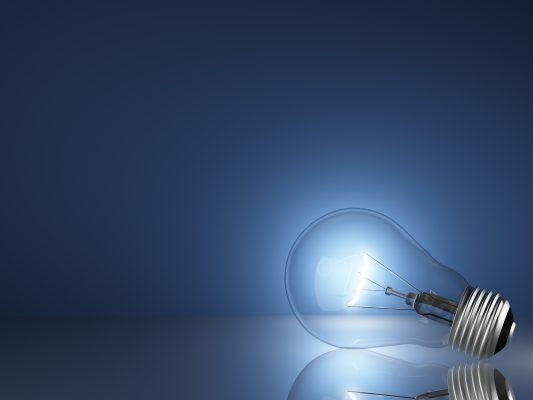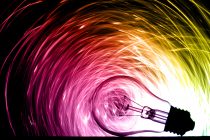Electric lighting became available less than 150 years ago but it provides a convenience most people would find difficult to live without today. The use of artificial light has undoubtedly increased our productivity by effectively extending the working day and improved our safety. However, many of our modern lighting sources also come with an electromagnetic radiation and hazardous material burden. In addition, artificial lighting is one of the major consumers of electricity. The health and environmental impacts of modern electric lighting will be covered in this course. For information on how light, natural and artificial, impacts the health of our visual, circadian, and skin systems see The Human Response to Light course. As Building Biologists, we have the opportunity to design and/or modify the lighting in spaces in a way that optimizes human health while minimizing the environmental footprint.
You can download this fact sheet by clicking here.
Today, most modern cultures rely on artificial light in the form of electrically powered light bulbs, also known as lamps. Lamps can be divided into three main categories: 1) incandescent, 2) discharge, which includes linear and compact fluorescent, and 3) solid-state, which are LEDs. Each lamp technology has different characteristics that are important to consider for making healthy choices for humans and the environment. In addition, the associated components of lighting, such as dimmers and electrical wiring should also be evaluated from a Building Biology perspective.
In Building Biology, we use nature as the gold standard. Thus, we look to the properties of natural light to guide us when choosing lamps. The emission spectrum of light refers to the distribution of the different wavelengths and thus colors. Sunlight follows a smooth and continuous emission spectrum with no wavelengths missing. The distribution of colors in sunlight changes throughout the day. Dawn and dusk have high levels of red and yellow and are low in blue, while midday is very blue-rich. Thus, we look for lighting with similar spectral emissions knowing that our needs change throughout the day. Caution should be used when choosing lamps labeled as full-spectrum as this term is not regulated and often does not represent the qualities of sunlight.
In addition to mimicking natural light we want electrical lighting with low levels of electromagnetic radiation and hazardous chemicals, while ideally low in energy use, and flicker free.
Incandescent bulbs work by conducting a current through a thin tungsten filament, resistively heating it to the point of incandescence. They are considered energy inefficient as most of the energy they consume (~90%) is released as heat rather than light. However, they are also free of flicker, low in all electromagnetic radiation, and low in hazardous materials. A regular incandescent bulb has a smooth spectral distribution close to that of sunlight during dawn or dusk.
Discharge lamps use electric current to excite a gas to illumination. These can be pressurized to achieve different spectral qualities. There are many types of discharge lamps. The most commonly used for general illumination in buildings are fluorescent lamps. Fluorescent bulbs are low-pressure discharge lamps where the gas is mercury. When mercury gas is excited by an electric current it emits mostly UV rays. The inner surface of the bulb thus must be coated with phosphors to convert the UV into visible light. There are two types of fluorescent lamps – linear, long tubular bulbs with a separate ballast, and compact, small lamps with the ballast built in. Fluorescent bulbs are 4 to 6 times more energy efficient than incandescent bulbs but can have issues with flicker and dirty electricity. Magnetic fields are also high for the magnetic-ballasted linear lamps. Of great concern is their mercury content, which poses a human and environmental health hazard at all life-cycle stages –production, use, and disposal. In addition, their spectral distribution is uneven with discrete narrow peaks at particular wavelengths and negligible emissions between peaks. Fluorescent lamps are, therefore, not recommended.
LEDs use solid-state, that is, semi-conductor technology. The technology of LEDs has advanced rapidly since they were first developed in the 1960s, and continues to do so. It is now possible to produce white LED lighting that comes close to emulating sunlight with a wide range of temperatures from 2700 K to 6500 K. LEDs are also very energy efficient. There is a large variation in the type and quality of components used in LED lamps today, resulting in end products that can differ tremendously in quality and thus, attributes related to health. Some LEDs generate high levels of dirty electricity and flicker. They also contain hazardous levels of lead and copper. Most LEDs on the market have a spectral distribution with two main peaks, one in blue and other in the warm color range. However, advances have seen the development of candlelight style LEDs, which have a spectral distribution very similar to sunlight. High-quality LEDs can be a good choice as long as dirty electricity levels are tested before using.
Dimmers are another important aspect to consider when making healthy lighting choices. Dimmers generally generate high levels of dirty electricity and can even be a fire hazard when combined with non-dimmable lamps. The lowest dirty electricity option is not to use dimmers at all. Instead, use multiple light sources with different illumination levels. Some dimmers, called constant current reduction dimmers, that are designed to be used, and matched with, compatible LED light bulbs are low in dirty electricity.
Lamp technology has advanced rapidly in the last few decades, not only with solid-state technology but also with the development of smart lighting and visible light communication. Smart lighting refers to wirelessly controlled lighting. As with any wireless technology, smart lighting is not recommended in Building Biology. Visible light communication, also called light fidelity (LiFi), is the transmission of data on light waves. The light waves themselves may be safe, however, the data transmitted on the light waves have to be modulated onto a carrier signal. At this nascent stage, the health implications of LiFi are unknown.
Humans are not the only organisms affected by electric lighting. The presence of light at night is a major stressor on wildlife, especially nocturnal animals. Light at night is a form of pollution and is called ecological light pollution in reference to plants and animals. Ecological light pollution can attract or repel different organisms leading to potential changes in their foraging, reproduction, migration, and communication. A change in the behavior and health of one species ultimately affects others, leading to disturbances at the ecosystem level. Ecological light pollution, for example, can set migrating birds on the wrong path, discourage female turtles from nesting, and even cause algal blooms in lakes by discouraging zooplankton from migrating to the surface to eat algae at night. For the health of all organisms, it is important to minimize this type of pollution.
(In plants, light is a crucial factor in their photosynthetic activities. Their photosynthetic organs (e.g. leaves and shoots) are drawn to light whereas their non-photosynthetic organs (e.g. roots) are repelled by it. This is important to ensure that the leaves will collect as many photons as possible while the roots are oriented towards the soil to absorb water and nutrients. While blue or white light makes the roots respond by growing away from it, red light, according to studies, makes the roots grow towards it. Reference 1)
Electric lighting is considered an integral part of life for most people today. Building Biology takes a holistic approach that looks at all aspects of lighting concerning the health of humans and the environment. This includes the type of lamps we choose as well as associated technology and reducing light at night pollution.
Want to learn more on this issue? Click the comprehensive online course, here below.
Reference 1/Further reading:
Photobiology Definition and Examples – Biology Online Dictionary. Biology Articles, Tutorials & Dictionary Online.


